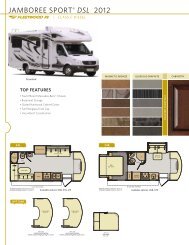You also want an ePaper? Increase the reach of your titles
YUMPU automatically turns print PDFs into web optimized ePapers that Google loves.
CAUTION<br />
Do not heat the <strong>RV</strong> interior with the range or oven.<br />
Open flames add moisture to the interior air. Do not<br />
use an air humidifier inside the <strong>RV</strong>. Water put into the<br />
air by the humidifier will in crease condensation.<br />
!<br />
WARNING<br />
Never use open flame Propane or kerosene-burning<br />
heaters indoors. These devices release water into<br />
the air, and the exhaust gases contain poisonous<br />
substances .<br />
!<br />
WARNING<br />
Do not cover emergency exit window(s). This<br />
window must be left accessible at all times for<br />
emergency exit.<br />
To increase ventilation:<br />
1 . Use the kitchen and bath exhaust fans, if<br />
equipped, when cooking or bathing . Let<br />
them run for a while after a bath or meal .<br />
2 . Ventilate with outside air . Partially open<br />
one or more roof vents and/or windows<br />
to provide circulation of outside air into<br />
the interior . While this ventilation will<br />
increase furnace heating load, it will<br />
greatly reduce, or eliminate, condensation .<br />
Even when it is raining or snowing, outside<br />
air will be far drier than interior air<br />
and will effectively reduce condensation .<br />
3 . Do not tape windows or doors closed .<br />
This will prevent any air movement and<br />
will make the condensation problem<br />
worse .<br />
4 . Ventilate closets and cabinets . During<br />
use in cold weather, leave cabinet and<br />
closet doors partially open to warm and<br />
ventilate the interiors of storage compartments<br />
built against exterior walls .<br />
The air flow will warm the exterior wall<br />
surface, and reduce condensation, and<br />
prevent possible ice formation . Avoid<br />
Living With Your Motor Home<br />
crowding closets or wardrobe space .<br />
Overstuffed closets restrict air flow.<br />
5 . Stock kitchen and bath cabinets to allow<br />
free air circulation .<br />
6 . Open window coverings and windows<br />
as often as possible and convenient .<br />
7 . Control the interior heat . Here are some<br />
tips on controlling humidity with heat:<br />
• Keep registers and the furnace blower<br />
clean and unobstructed . This helps air<br />
circulation .<br />
• Do not operate a humidity device on<br />
your furnace .<br />
Dripping Ceiling Vents<br />
During cold weather condensation frequently<br />
forms on ceiling vents and may even accumulate<br />
to the point of dripping onto the surfaces below .<br />
This is frequently misinterpreted as a “leaking”<br />
roof vent but is most often condensation . Follow<br />
the preceding steps to control moisture condensation,<br />
and protect surfaces with plastic sheeting<br />
until the moisture has dissipated .<br />
IMPORTANT INFORMATION<br />
Mold is a fungus that occurs naturally in the<br />
environment and serves necessary functions<br />
including aiding in the decomposition of plant<br />
and other organic material . Mold spreads by<br />
means of microscopic spores borne on the wind<br />
and is found everywhere life can be supported .<br />
Mold has existed for millions of years, and<br />
human beings have coexisted despite their exposure<br />
to mold and mold spores .<br />
If the proper conditions are present, mold can<br />
and will grow in your recreational vehicle . Most<br />
<strong>RV</strong> owners are familiar with mold growth in<br />
the form of bread and cheese and on bathroom<br />
tile, In order to grow, mold requires a food<br />
source . These food sources might be supplied<br />
by items found in the <strong>RV</strong> such as fabric, carpet,<br />
wallpaper, or building materials (i .e ., wood, and<br />
insulation) . Also, most mold growth requires a<br />
temperate climate . The best growth occurs at<br />
06-9






